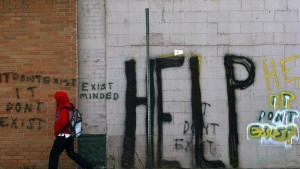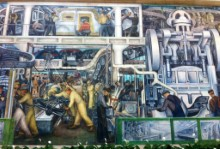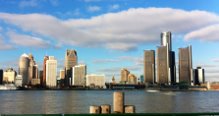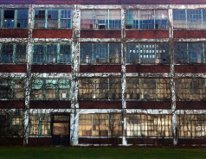Detroit, 20 December 2014
‘Obsolescence is the hallmark of progress‘, Henry Ford II, 1955.
Detroit is now unlike any other city in the world. As the heart of the American car industry, Detroit images American capitalism in its best and worst forms: inventiveness and dreadful labor relations. And Detroit is not standing under the best shape at all. As a matter of fact it is in real danger of becoming obsolete. Can both the city and the car industry turn around in the coming years?
Detroit is not alone in its dire conditions. Most of the Great Lakes cities have suffered steep industrial decline and vanishing populations. Whereas Cleveland and Buffalo have sort of stabilized and managed a mini rebound,
Populations 1960 2008 % change
Detroit 1.67 M 0.91 M -46%
Cleveland 0.87 M 0.43 M -50%
Buffalo 0.53 M 0.27 M -49%
Milwaukee 0.74 M 0.60 M -19%
Detroit has seen its population further erode to 0.68 M in 2013, a roughly 60% drop from the peak of 1.67 M people in 1960. What has happened in a matter of 50 years to cripple the 4th largest city in the USA?
Detroit literally invented the American urban doughnut: rich suburbs and downtown decay. It was first to build expressways and first to build suburban shopping malls. All the while the unemployed and the blacks started to populate the downtown area in the 1950s. To increase production quota in world war II, Detroit not only imported black labor from the South, but took white managers from the South too. In effect it imported the whole segregation conflict, lock, stock and barrel. The rot expanded and sure enough serious riots exploded in Detroit in 1967, imprinting deep scars in the urban tissue. Oblivious to these mounting tensions, Detroit had even applied to be the host city for the 1968 Olympics (they were held in Mexico city). Gradually blacks moved into municipal employment and came to control and dominate city unions. The ever conflict continues to fester and pester. My uncle was working in the car factories of Detroit in the 1960s and 70s and was always carrying a gun or two in his car. Such was life and insecurity then.
Detroit had gone through difficult times before. In 1932, at the peak of depression, Ford commissioned Diego RIvera to paint a monumental fresco at the Detroit Institute of Arts (DIA). Then, Detroit had a population of 1.56 M people, but 311,000 auto workers had just recently been laid off. Diego duly spent a month at the notorious Ford Rouge factory, observing and understanding. Not so astonishingly, Diego’s interpretation of the car industry included the Aztec god Tlaloc inside the painting, a god requiring human sacrifices. Today the mural ‘Detroit industry’ stands as the noted masterpiece of the museum, as if the godly curse had come to devour the city. The Ford Rouge plant eventually recovered and came to employ 60,000 workers in the 1950s but subsequently declined to 6,000 workers in 1999.
After the riots, the oil shocks of the 1970s proved to be the second shock to Detroit. The big 3 auto makers steadfastly relied on the larger car models to make money because of their higher margins. The Japanese saw their advantage in the low end of segments: high quality small cars with low gas consumption. For 2 decades the Japanese kept chipping away market share from the big 3 auto manufacturers as they moved up market. In fact, when Toyota launched the Lexus in 1989, the big three readily acknowledged that they could not themselves build such a luxury car. The relentless Japanese competition on quality was the 3rd shock to an industry built upon mass production with average quality. When Japanese car makers in turn built factories in America, they kept far from Detroit and its poisonous labor relations.
Wall Streeters are much despised in Detroit. The financial crisis of 2008 was a serious blow to the city and car companies. GM declared bankruptcy and Chrysler fell into the hands of Fiat. Ford managed to escape. Last 17 December, the Chrysler Group LLC name was ominously dropped for good, and was officially renamed FCA US LLC (Fiat Chrysler Automobiles).
The competitive landscape has in the meantime become more complex and more competitive as the Koreans have joined the big leagues. Can the GM towers, anchored by the river, regain clout in the markets? The future of the car industry essentially depends on a range of quality and design that bundles into a package of emotion and passion for car buyers. When you wander in the GM Renaissance towers, you cannot help but observe the grayness of the office floors all modeled on the same cubicle patterns, floor after floor after floor. In a nutshell, we are strolling into the kingdom of Dilbert. My guide was enthusiastically describing the towers as the last pristine site in Detroit. I thought they looked like vertical straight jackets.
As for the city, some green shoots of recovery have lately popped up here and there. Youth seems to be tentatively back in town to the great relief of long time residents. Tech incubators, cooperatives, social entrepreneurs and real estate speculators have taken delicate roots in the city. Detroit is endowed with great buildings in the downtown area and the DIA is an outstanding proof of the mighty peak of industrial Detroit. Professional sports provide some of the central glue that is still keeping this sprawling city into one piece. Soon, the Joe Louis hockey arena will be moved next to the baseball and basketball stadiums in the downtown area. But can the younger generation battle back a dysfunctional city, massive corruption at town hall and powerful unions acting as nests of self interests? Detroit is ulcered with a backlog of 110,000 vacant buildings, creating scores of pockets of war-like zones in a city that is large enough to absorb San Francisco, Boston and Manhattan within its boundaries. Thus about 30% of 140 square miles are vacant. Neighborhood initiatives aiming at reviving the creative spirits are facing the recurrent onslaughts of vandalism fueled by the nation’s 3rd largest population of homeless, drug violence and hordes of scavengers.
Will the city work better after bankruptcy? Will the car industry be prepared to face the next electric shock? Clearly the old traditional American capitalism has been failing in Detroit. In any event the country has moved on. Other cities such as Houston, San Antonio, San Diego and Denver have all seen population growth in excess 120% during the same period. As we are moving towards intelligent cities driving economic growth, Detroit is a reminder that cities rise and fall in the great melting pot of the USA. Few industries and governments were prepared for the rise of industrial China in 2000 and fewer properly drilled their companies to the competitive tsunami. It was then thought that the competitive response from the pool of SMEs of each country or region would come to redefine the new economic order over the forthcoming decades. And so it has been.
As the next phase of the digital revolution makes its assault on our lives, it will now be the health of city-regions that will make the difference in economic prosperity. It will be about how cities attract and mobilize resources, such as creative talent, new investments and cutting edge R&D within the new digital frontier. Can cities develop new forward looking policies and redefine their municipal landscape? Can cities go beyond mere cluster building and actually make them work? Unfortunately, the municipal record in North America is riven with some of the worst examples.
Good luck Detroit.
André Du Sault, MBA, MPA





0 Responses
Stay in touch with the conversation, subscribe to the RSS feed for comments on this post.